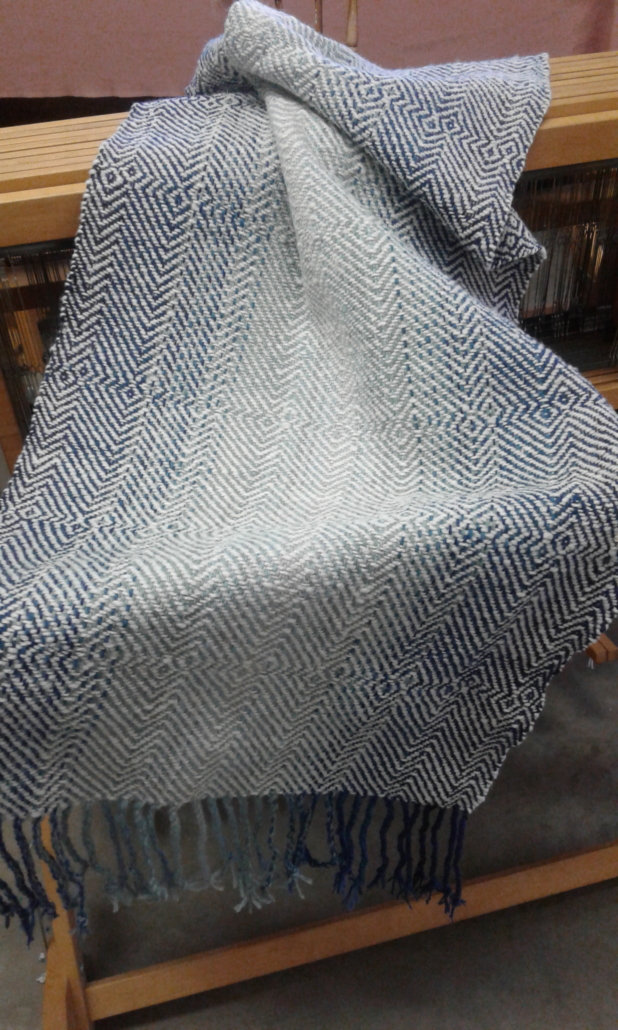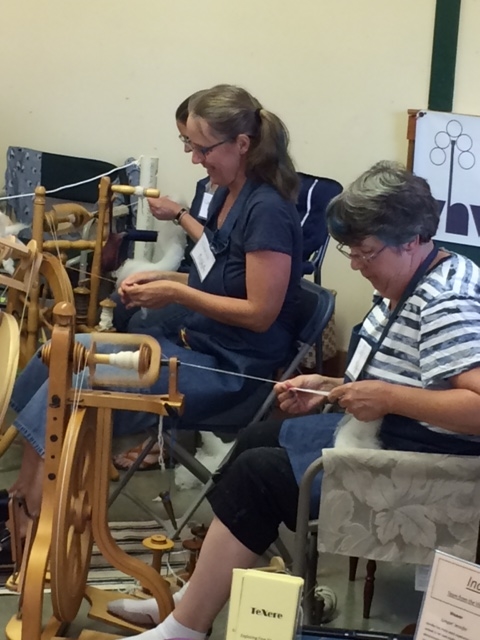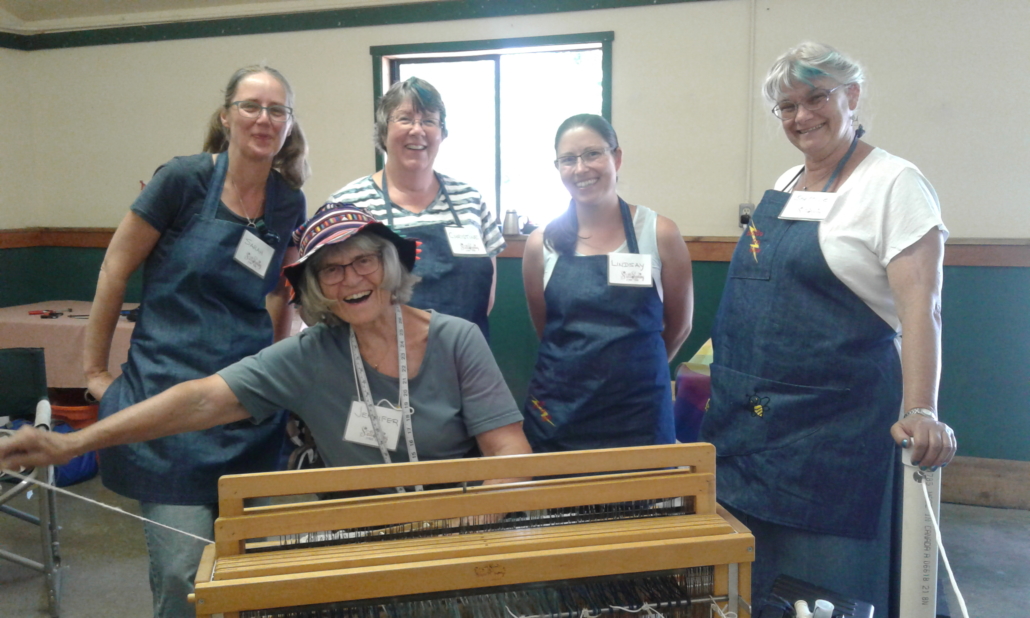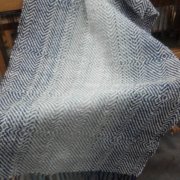Guilded: Creating Community Through Cloth
Words and Photos by Sarah Thornton
There’s a piece of cloth in my office: a shawl, about 22×72 inches, with twisted fringe, woven in a simple 4-shaft twill. The weft is a 2-ply white wool – nothing too special, rather coarse in fact, and somewhat unevenly spun and plied. The warp is a mirrored gradation of blues, from dark on the outer borders to light in the middle sections – all handspun of varying colours, textures, and grists. The drape is, well, to put it kindly, more that of a heavy blanket than of a shawl. But none of those details matter to me. This shawl is more than it appears.

My team wove the shawl in July 2018 at a Sheep to Shawl competition held as part of the Salt Spring Island Fibre Fair. The fair was a 2-day event of classes, vendors, and demonstrations, and the competition was a key part. Salt Spring Island is one of the Gulf Islands of British Columbia, situated in the Salish Sea between Vancouver and Vancouver Island. The island is known for its sheep, Garry Oak meadows, artisans, and local food. Their Saturday Market attracts tourists all summer long. It’s a 35-minute ferry ride from Victoria or an hour from Vancouver and is an all-round delightful place to visit.
Planning the Shawl
At the Victoria Handweavers and Spinners Guild, we heard about the upcoming event and decided we had to field a team! Our Island guilds are a friendly bunch, and we love getting together at various fibre fests and spinning events throughout the year. This time, we’d throw some friendly competition into the mix.
We needed a theme for our team of 5 people – the section for “team spirit” was a significant amount on the score sheet! Brenda and I brainstormed – we love blue and knew we would need to work quickly to finish a shawl in the 5-hour limit. I definitely wasn’t thinking of the online fundraising website or the 90s music folk rock duo, but between the two of them, the Indigo-Go Girls was born. We had a name and a theme! Now, what should the shawl look like? We knew our weft would be white – we’d seen a small sample of the fleece – and an indigo warp would set off that white weft well. We solicited donations of blue handspun skeins from other guild members, and Jennifer and Brenda planned and made the warp. Plain weave is fast but isn’t too eye-catching, so twill it would be. I have to admit, I’m not much of a weaver, so when I asked for lightening bolts… But Jennifer did a great job with the interpretation, I thought! Other guild members donated time to sew our aprons. July approached. Even though we’d done lots of planning in advance, we hadn’t actually managed to practice at all. Generally, a successful sheep to shawl team will have some sense of how long it takes to produce the kind of yarn they want, but somehow getting together eluded us. Our team had challenging work and travel schedules, but we all knew each other and had seen each others’ spinning and weaving, so we hoped we could manage and adapt on the fly.
Arriving for the Competition
My fiancé and I took the opportunity for a short vacation and rented a small cottage for 4 nights. A teammate and her husband joined us for 2 nights. The reality of the ferry schedules meant all participants had to stay on the island the night before the competition.
Bright and early on Saturday morning, we delivered all the equipment to the Farmers Institute hall – 4 spinning wheels (3 to use and a spare, just in case!), a drum carder, a loom and bench, various extra tools, and the display boards explaining our process. Also important, the bluetooth speakers and tablet to play our spinning tunes! (We did check with the judge and other teams about having the music, and they all knew they could ask us to turn it off/down at any time). At the last minute, we found the bobbins for one of the wheels which had been packed into a different box for transportation – crisis averted.
Each guild had a cordoned off area in the hall. We all had 5 team members – one weaver, 3 spinners/plyers, and one gopher/fibre prep person. The rules were clear – no more than 3 people could be spinning at once, and the gopher could only step into a weaving or spinning role if the original person was taking a break. We donned our costumes – denim aprons with the team logo embroidered onto the pocket, blue chalk in our hair, glittery blue nail polish (for some!), and denim capris/shorts or skirts.
The three teams approached the judging table for last-minute instructions and drew numbers to choose a fleece. All 3 were Cheviot crosses, and unfortunately, all had issues, though each in a different way. Ours seemed to have short coarse hairs sprinkled liberally throughout, which we didn’t take the time to remove at first. Ah well, had we known how quickly we could work (remember that lack of practice?), we could have done a better job!
Jumping Right to Work
Just before 10 am, the whistle blew and my teammates jumped right to work. But before joining them, I jumped to the tablet and pressed play to start the playlist! “Greased Lightnin’” filled the air – it was time to get going! Next came “Wake me up before you go-go,” and then the spinning and weaving tunes started (see full playlist below).
This competition allowed the use of a drum carder, so that was our prep tool. Three of us started pulling fleece apart, and Beatrice loaded the carder and started cranking. Within just a few minutes the first carded batt was ready, and Lindsay and Christine got down to the spinning.

Jennifer and I continued sorting fleece, and Beatrice got going on the next batt. As soon as the spinners had 1/3 bobbin each, I started to ply. I quickly handed off my bobbin to Jennifer, who readied her weaving bobbin and got to the weaving. A cheer went up as she threw the first pick!
The minutes flew by. At one point, the whole room was singing along when Darius Rucker sang “Wagon Wheel” – the tunes helped keep our energy high. Some competitions allow for a team break, but not this one! We swapped out as needed for bathroom, food, and fresh air breaks, and we were making good enough time that I took a few minutes to check out the competition as I ate a sandwich. As the hours accumulated, though, we all began to flag. But then Jennifer said our shawl was long enough! She had more than enough weft to finish the last few inches. So as she threw those last few picks, we spinners cleaned up and prepped our table for fringe twisting. It must have been quite a sight – 5 of us intently bent over the shawl, twisting fringe on both ends at once, from both sides. And then we were done! A full 15 minutes before the final bell rang at 3 pm.

The Results
After the final judging was completed, we received second place – while we did finish the fastest, our spinning was a bit less consistent than the winning shawl and our shawl only just met the minimum length requirement (it shrank over 15% after coming off the loom and waiting for judging). We were finally able to chat with our fellow participants and see the beautiful shawls they created. And then we headed off for a swim in the lake (Jennifer) and much-deserved cold drinks!
All 3 teams created cloth – a shawl of minimum size 18×72 inches – but we created more than just cloth. We created community. Each team consisted of 5 members during the competition, but many more guild members participated, from providing warp yarns to cheerleading and interacting with the public who came to watch the event. We also created an amazing teaching tool in the shawls we made. How often are we, as spinners and weavers, asked how long it took to make a particular item? How long does it take to spin for a sweater? For a shawl? The answer is always “it depends,” but with the competition shawl, we now have a tangible piece that gives us a metric. We know that all the carding, spinning, plying, weaving, and fringe twisting took 5 people 4.5 hours, so 22 hours total. And that wasn’t working extremely carefully – our technique definitely leaned towards fast rather than good! We learned a lot. We now have an estimate of how quickly we can work, so we know to take more care and time at the beginning with the carding and that we have some extra time for getting the spinning consistent.
On a personal note, the cloth we created is very special to me. I moved away from Victoria in the fall of 2018, leaving my guild and friends of 11 years. My teammates decided I could have the shawl we made. I am so happy to have a warm reminder of our very fun day on Salt Spring Island. And I still get “Dream Weaver” stuck in my head whenever I see the shawl!
The Playlist
- Greased Lightnin’ – John Travolta
- Wake me up before you go-go – Wham!
- It Don’t Mean a Thing (If It Don’t Have the Go-Go Swing) – Chuck Brown and the Soul Searchers
- Don’t Go Breaking My Heart – Elton Jon and Kiki Dee
- You Spin Me Round (Like a Record) – Dead or Alive
- Spinning Wheel – Blood, Sweat, and Tears
- Spinning Around – Kylie Minogue
- Spin Our Wheels – Sloan
- World Spins Madly On – The Weepies
- Spinning Like a Top – The Devil Makes Three
- Spinnin’ N Reelin’ – Creed Bratton
- Roving Gambler – Hart Valley Drifters, Jerry Garcia
- Jolly Roving Tar – Great Big Sea
- Dream Weaver – Gary Wright
- Weave Me the Sunshine – Peter, Paul, and Mary
- Weave On – Serj Tankian
- The Goddess and the Weaver – Spiral Dance
- Wagon Wheel – Darius Rucker
- Wheel in the Sky – Journey
- Wheels on the Bus – Raffi
Sarah Thornton is an ocean scientist by training and educator by vocation. From 2007–2018, she lived on Vancouver Island, getting involved in all sorts of fibre pursuits. She now lives in Vancouver and teaches knitting, spinning, and college biology and competes in sheep to shawls with her new fibre community.




Leave a Reply
Want to join the discussion?Feel free to contribute!